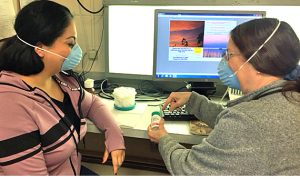McHenry County Department of Health sponsors TB awareness
Adela Crandell-Durkee for Chronicle Media — April 5, 2017
Karen Stephenson (right), TB Nurse, counseling a patient about TB medication. (Photo courtesy of McHenry County Department of Health)
March 24 was World TB Day.
Although tuberculosis might be forgotten by most, it is not gone. In the early 1900s TB killed one out of every seven people living in the United States and Europe.
Even though that is no longer the case, the Centers for Disease Control and Prevention (CDC) estimates that today about a third of the world’s population is living with TB. According to statistics from the CDC there were almost 10,000 TB cases in the United States in 2015. Worldwide, 10.4 million people became sick with TB and there were 1.8 million TB-related deaths.
According to Susan Karras, assistant director of public health nursing at MCDH, there are two types of TB: active and latent.
Latent TB can remain in the body for years, undetected. Active TB is infectious, and is therefore tracked by MCDH.
Although the incidence of active TB in McHenry County is low, only two in 2016, one was classified as “extensive resistant.” The patient required treatment at the national Institute of Health in Bethesda, Md. Active cases require a thorough “contact” review to identify exposed people. People with Active TB are not allowed to travel by air because of the risk of infecting passengers.
MCHD’s goal is to discover and treat the latent form before it becomes infectious. In 2016, they identified 75 latent cases of TB through skin tests or blood tests. The most common reason people are tested are for employment, or for school, or as part of the immigration process.
The treatment for active or latent TB is 3-6 months of antibiotics. According to Karras, “McHenry County has a low rate of infection compared to surrounding counties because we require people with latent TB to come to us to get the medication.”
That way they have a higher compliance rate. Among the reasons the TB rate is low in the USA is that the CDC’s policy is “directly observed therapy” for active cases.
Karras said that the drugs have side effects and the therapy is long, so patients often discontinue treatment. Noncompliance to therapy is a major contributor to the development of antibiotic resistant strains. In cases of antibiotic resistant TB, the therapy can take 3-4 years.
HIV/AIDS and active TB often occur together. For that reason, when one is diagnosed, the patient is tested for the other.
Karras wants everyone to know that TB is not eradicated. “It’s a disease that doesn’t get enough attention because it’s not as exciting as something like Ebola.”
What you should know:
- You cannot get TB from surfaces such as clothes, drinking glasses, shaking hands or eating utensils.
- TB is a bacteria that is spread through the air when someone with active TB of the lungs or throat coughs, laughs, sings, or sneezes.
- People near the sick person can breathe in the germs.
- TB germs can live in your body without making you sick. This means you have inactive (sleeping) TB germs in your body and they cannot be passed on. However, if they become active and multiply, you will get sick with TB disease and can spread the TB germ.
Most often, TB bacteria grow in the lungs causing symptoms such as a bad cough, chest pain and coughing up blood or sputum. Other symptoms are often weakness, fatigue, weight loss, chills, fever and night sweats.
McHenry County Department of Health conducts contact investigation and case management for TB cases, offers TB testing and provides treatment, if needed, to those at high risk for developing TB. The Department’s TB Clinic in Woodstock makes available chest X-rays, diagnostic studies, laboratory services and medication to any person who works or resides in McHenry County.







